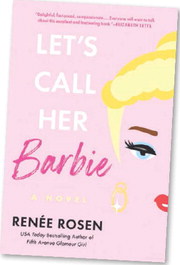BOOK REVIEW
Looking great is serious business.
Skincare, hair care, make-up and jewelry, it all takes time to get it right. You might watch your weight. You keep tabs on your physical and emotional health. Fashion is at the top of the list for looking great, and that’s a lot of work, too. Indeed, as in the new novel, “Let’s Call Her Barbie” by Renée Rosen, haute couture is nothing to toy with.
At first, Elliot Handler underestimated his wife, Ruth, but it didn’t take her long to prove her mettle. Ruth was capable, smart, fearless, and by 1956, she was president of the company she co-founded. So when the Mattel design staff balked at her idea for a new kind of doll for little girls, well, they should’ve known Ruth wasn’t going to take “no” for an answer.
But creating a grown-up fashion doll would be an uphill battle: the prototype that Ruth handed to her research and development head, Jack, had to be altered to avoid lawsuits. The doll, named Barbie, after the Handlers’ daughter, was strictly kept under wraps to avoid theft of ideas from competitors in the industry. Ruth needed to hire clothing designers to give her new creation a wardrobe and little girls a reason to keep buying Barbie’s accessories.
But the biggest hurdle was consumers — most notably, mothers. Ruth hoped to tap into the new medium of television, with advertisements for Mattel’s new doll; she knew that once young girls actually saw Barbie, they’d want one despite their mothers’ reluctance.
And she was right. By 1960, Barbie was a smash hit but behind the scenes, things weren’t running so smoothly.
The real “Barbie” hated everything about her namesake, and she shunned her mother for it. Jack was wild, drinking, using drugs and womanizing his way through the staff, including Mattel’s best up-and-coming clothing designer. And Ruth knew that stress was getting to her, which worried her. She smoked too much, and everybody knew cigarettes caused cancer … So here’s what happens when you set “Mad Men” in a toy factory, toss in actual events and real people, then sprinkle it with an extra bit of drama. Yummy: “Let’s Call Her Barbie.”
Because it’s based on true events and features mostly real characters, it’s easy to forget that this story is a novel. Author Renée Rosen does such a fine job telling a tale that readers — especially those who had a big collection of Barbie dolls beneath their bed, way back — will be totally captivated, and immersed in this entire book, the business side of it, the personal side of it, all of it. This story speaks directly to the heart of little girls now grown, and it brings back some of the best parts of childhood, favorite toys and playtime.
At the end of this novel, Rosen reveals to readers who in the story was real and who was not, but resist and don’t peek! Just enjoy “Let’s Call Her Barbie” at its own leisurely pace, and loving it is child’s play.




